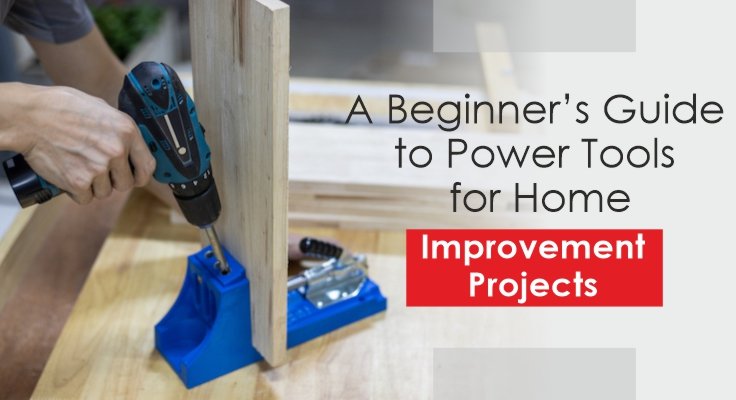Home improvement projects can be incredibly rewarding, allowing you to personalize your space, enhance its functionality, and even increase your property’s value. For those just starting out, the world of power tools can seem overwhelming.
With so many options available, it’s essential to understand which tools are necessary, how to use them safely, and how to get the most out of each one. This comprehensive guide will introduce you to the basics of power tools for home DIY, offering valuable insights to help you confidently embark on your home improvement journey.
Understanding the Basics
Power tools are essential for any serious DIY enthusiast. They make tasks quicker, more efficient, and often more precise than manual tools. Here are some of the most common power tools that every beginner should consider:
Drill/Driver
- Function: Drilling holes and driving screws.
- Types: Corded and cordless. Cordless drills offer more mobility, while corded drills provide consistent power.
- Key Features: Variable speed settings, clutch settings to control torque, and a reverse function for removing screws.
Circular Saw
- Function: Making straight cuts in various materials, primarily wood.
- Types: Sidewinder and worm drive. Sidewinder is more common and lighter, while worm drive offers more torque.
- Key Features: Blade size, bevel capacity, and depth adjustment.
Jigsaw
- Function: Making curved and intricate cuts in wood, metal, and plastic.
- Key Features: Variable speed control, orbital settings for different cutting actions, and tool-free blade changes.
Sander
- Function: Smoothing surfaces by abrasion.
- Types: Orbital, random orbital, and belt sanders. Random orbital sanders are versatile and less likely to leave swirl marks.
- Key Features: Variable speed control and dust collection systems.
Impact Driver
- Function: Driving screws and bolts with high torque.
- Difference from Drill: Provides more torque and less effort for driving screws, making it ideal for heavy-duty tasks.
Angle Grinder
- Function: Cutting, grinding, and polishing different materials.
- Key Features: Disc size, variable speed settings, and compatibility with various attachments.
Miter Saw
- Function: Making precise crosscuts and angled cuts.
- Types: Compound miter saws can tilt for bevel cuts, and sliding miter saws can handle wider materials.
- Key Features: Positive stops for common angles and a laser guide for accuracy.
Choosing the Right Power Tools
When selecting power tools, consider the following factors:
- Purpose: Identify the types of projects you plan to undertake. Different projects may require different tools.
- Budget: Power tools can range from affordable to expensive. Prioritize quality and reliability within your budget.
- Brand Reputation: Opt for reputable brands known for durability and performance. Brands like DeWalt, Makita, Bosch, and Milwaukee are well-regarded.
- Ergonomics: Ensure the tool feels comfortable in your hand. Consider weight, balance, and grip.
- Power Source: Decide between corded and cordless tools. Cordless tools offer convenience, while corded tools provide consistent power.
Safety First
Using power tools can be dangerous if proper safety precautions are not taken. Here are some essential safety tips:
- Read the Manual: Always read the user manual for each tool. Understand its operation, limitations, and safety features.
- Wear Safety Gear: Use safety glasses, hearing protection, and dust masks. For some tasks, gloves and steel-toed boots may also be necessary.
- Inspect Tools Regularly: Check for any damage or wear before use. Ensure all guards and safety devices are in place.
- Keep Work Area Clean: A cluttered workspace can lead to accidents. Keep your area clean and organized.
- Use the Right Tool for the Job: Using a tool for a purpose it wasn’t designed for can be dangerous.
- Avoid Distractions: Stay focused on your task and avoid distractions.
- Unplug Tools When Not in Use: For corded tools, always unplug them when not in use or when changing accessories.
Essential Power Tool Projects for Beginners
Now that you have an understanding of the essential power tools, let’s explore some beginner-friendly projects to help you get started.
Building a Simple Shelf
- Tools Needed: Drill/driver, circular saw, sander.
- Steps:
- Measure and mark your wood.
- Cut the wood to size using the circular saw.
- Sand the edges for a smooth finish.
- Assemble the shelf using screws and the drill/driver.
Constructing a Planter Box
- Tools Needed: Drill/driver, circular saw, jigsaw, sander.
- Steps:
- Cut the wood to size using the circular saw and jigsaw for curved edges.
- Sand the pieces to remove any splinters.
- Assemble the box using screws and the drill/driver.
Creating a Picture Frame
- Tools Needed: Miter saw, sander, drill/driver.
- Steps:
- Measure and mark your wood.
- Use the miter saw to cut 45-degree angles for the corners.
- Sand the pieces for a smooth finish.
- Assemble the frame using screws or nails.
Installing Floating Shelves
- Tools Needed: Drill/driver, level, stud finder.
- Steps:
- Use the stud finder to locate studs in the wall.
- Mark the positions for the brackets.
- Drill pilot holes and attach the brackets using the drill/driver.
- Place the shelf on the brackets and secure it in place.
Building a Workbench
- Tools Needed: Circular saw, drill/driver, sander.
- Steps:
- Measure and cut the wood to size using the circular saw.
- Sand the pieces to remove any rough edges.
- Assemble the frame and attach the top using screws and the drill/driver.
Maintenance and Care
To ensure your power tools last and perform optimally, follow these maintenance tips:
- Clean Regularly: Remove dust and debris after each use. Use compressed air for hard-to-reach areas.
- Lubricate Moving Parts: Regularly lubricate parts as specified in the user manual.
- Store Properly: Keep tools in a dry, clean area. Use cases or storage solutions to protect them.
- Replace Worn Parts: Check for and replace any worn or damaged parts immediately.
- Sharpen Blades: Keep blades sharp for efficient cutting and reduced strain on the tool.
Conclusion
Embarking on home improvement projects can be both exciting and daunting for beginners. With the right power tools and a solid understanding of how to use them safely, you can confidently tackle various projects. Start with basic tools and gradually expand your collection as your skills and needs grow. Remember to prioritize safety, maintain your tools, and enjoy the process of transforming your home. With practice and patience, you’ll soon become proficient in using power tools to create, build, and improve your living space. Happy DIY-ing!










